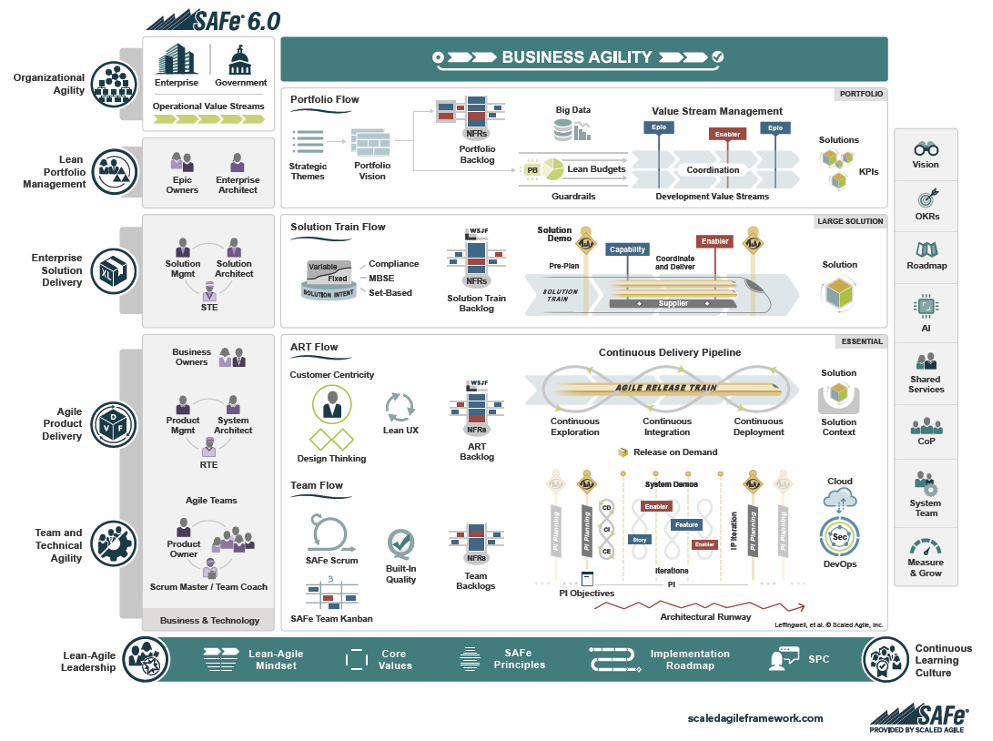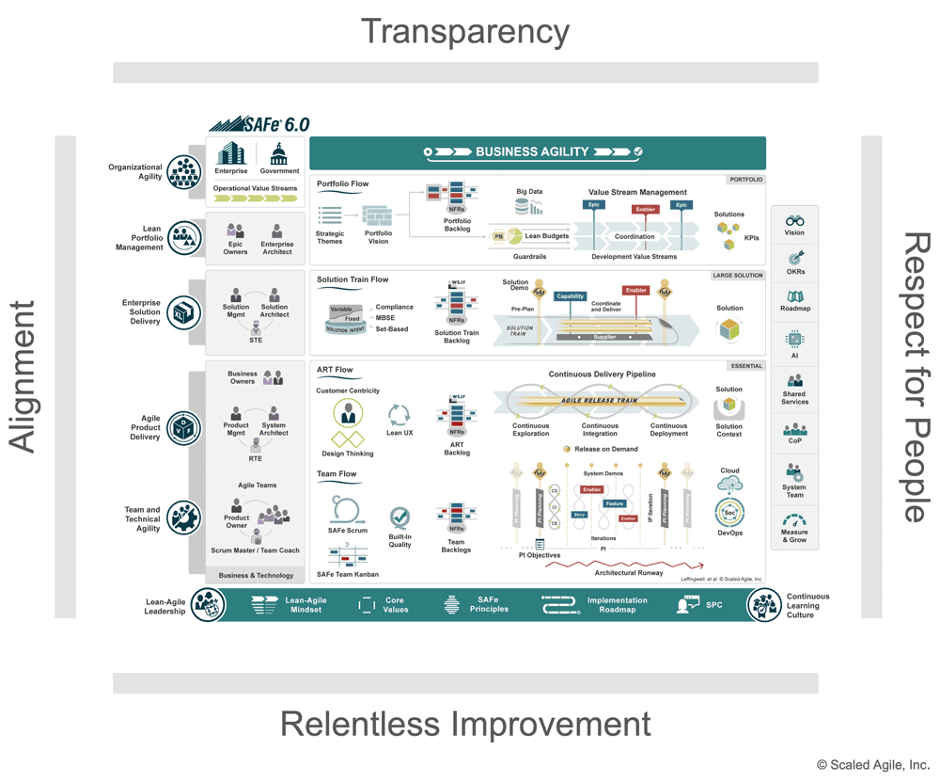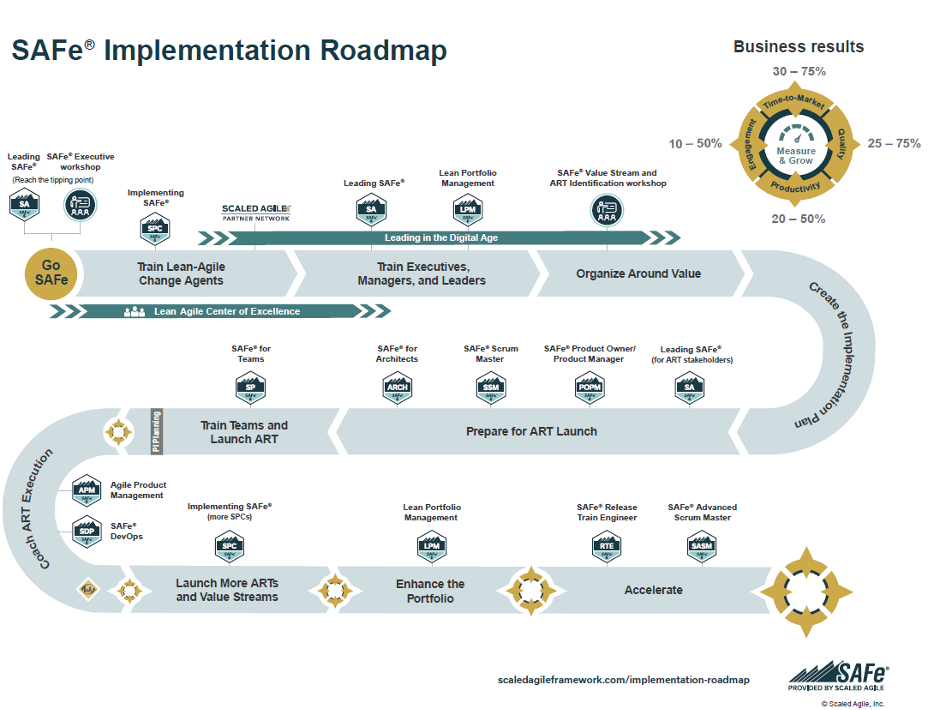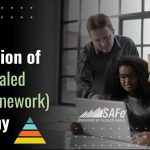Here we answer the question “What is Scaled Agile Framework (SAFe) mean in simpler terms?”. Learn how it helps scaling Agile to achieve Business Agility and find out the four levels of the Scaled Agile Framework.

What is the Scaled Agile Framework? What is SAFe?
Often we get this question from our readers, What is SAFe? Is Scaled Agile Framework any good? What is the difference between Agile and Scaled Agile Framework? What is the Scaled Agile Framework?
Today we will answer all these questions in this in-depth overview of Scaled Agile Framework.

Scaled Agile Framework helps to achieve Business Agility by creating a nimble organization that can quickly react to change, create a culture of happier, motivated people who are more productive and accelerate speed to value for both customers and the organization. SAFe helps organizations deliver better business outcomes by helping focus on innovation, customers and products by acting as a dual operating system.
It is built on leveraging the knowledge bodies of Lean, Agile, Systems Thinking and DevOps. Scaled Agile Framework is a framework for agile product and services development and management at the enterprise level.
The Scaled Agile Framework is a body of knowledge that incorporates knowledge ideas tools and techniques on things like planning, roles and responsibilities, work management and agile practices and values.
It utilizes the Scrum Framework at the Agile Team level along with the Lean Business Value Stream approach and Kanban to visualize flow to deliver high-quality products and services faster.
Scaled Agile framework helps large organizations achieve greater agility. It speeds up feedback between stakeholders, leading to increased engagement, productivity, job satisfaction, and faster delivery of better products.
What are the 4 levels of the Scaled Agile Framework?
Given SAFe is scalable and configurable gives enterprises an option to start implementation from a small team and then scale it to program and portfolio level. SAFe gives the organization a structured approach for scaling its agile practice to the level that it needs via four different configurations.
The Essential Configuration – This is the basic building block for all SAFe configurations. It operates at the level of a team or a project or a simple program. It is the simplest starting point for SAFe implementation. It provides the Lean-Agile Leadership competency, the Team and Technical Agility competency, the Continuous Learning Culture competency, and the Agile Product Delivery competency.
The Portfolio Configuration – Provides the Lean Portfolio Management competency which aligns portfolio execution to company strategy. It organizes development around the flow of value through one or more Value Streams. It introduces governance, strategy and value stream thinking.
The Large Solution Configuration – Works at the multi-project or multi-program level which supports those building the largest and most complex solutions that require multiple Agile Release Trains and suppliers, but where there isn’t a consolidated portfolio approach to bringing all the projects and programs together.
The Full Configuration – This is integrating all of the above three approaches into a single coherent allowing the enterprise to implement agile at all levels simultaneously in a way that is entirely consistent as you move up and down the levels of the hierarchy from the smallest team and project to the largest portfolio manager. This includes all seven core competencies of the Lean Enterprise. It is the most comprehensive version of the Framework and supports Enterprises that build and maintain a portfolio of large and complex solutions.
What are the 4 Scaled Agile Framework Core Values?
The Scaled Agile Framework considers the four core values fundamental to its successful implementation to achieve Business Agility.
In the SAFe 5.1 version, the 4 Scaled Agile Core Values were:
- Transparency
- Alignment
- Program Execution
- Built-in Quality
In the latest upgrade to SAFe 6.0, the two core values of Program Execution and Built-in Quality have been replaced.
The 4 Scaled Agile Core Values in SAFe 6.0 are:
- Transparency
- Alignment
- Respect for People
- Relentless Improvement

SAFe’s Four Core Values
Transparency: Transparency is required to learn from mistakes and leverage data to develop the solution. To allow for Transparency in an organization it is important to foster Trust.
Without a culture of transparency and trust, it will be impossible to build high-performing teams and thus fail the new ways of working introduced by SAFe implementation.
Alignment: The idea of SAFe agile methodology is to reduce time to market and reduce unnecessary distractions. However, if teams and leadership are not aligned and making different decisions, it will hamper value delivery.
Having a connection between strategy and execution with a clearly communicated vision, mission and strategy are pivotal to bringing alignment in an organization.
Respect for People: Any product and solution development is a team sport, where people do all the work. Respecting people is a basic human need and will allow for highly motivated employees working with creativity irrespective of the situation.
Valuing diversity of people and opinions, coaching and mentoring employees, and treating internal and external customers with respect and empathy are all ways in which the Scaled Agile Framework promotes Respect for People.
Relentless Improvement: The SAFe Scaled agile methodologies require learning from feedback and being able to pivot when needed. All this requires a culture of Relentless Improvement in a SAFe enterprise.
The only way to embody these 4 core values of the Scaled Agile Framework within the DNA of the company is by having Leaders exemplify them and actively support a Lean-Agile Mindset and culture.
What are the 10 SAFe Scaled Agile Framework Principles?
SAFe Scaled Agile Framework is built on leveraging the knowledge bodies of Lean product development, Agile Values and Principles, Systems Thinking and observations made from several successful enterprises.
Each company faces its own unique challenges and hence there is no off-the-shelf solution to solve the problems. This will influence the way we implement SAFe recommended practices and hence leveraging the 10 SAFe Scaled Agile Framework Principles will help fundamentally address the problem.
Scaled Agile Framework is based on ten foundational, fundamental Lean-Agile principles. These influence the roles and practices of the SAFe Scaled Agile Framework.
The 10 SAFe Scaled Agile Framework Principles are:
- Take an economic view
- Apply systems thinking
- Assume variability; preserve options
- Build incrementally with fast, integrated learning cycles
- Base milestones on objective evaluation of working systems
- Make value flow without interruptions
- Apply cadence, synchronize with cross-domain planning
- Unlock the intrinsic motivation of knowledge workers
- Decentralize decision-making
- Organize around value
What is the difference between SAFe vs Scrum?
The key difference between Scrum and SAFe Frameworks is that the former helps in achieving team agility whereas the latter is to achieve enterprise-wide agility i.e. Business Agility.
Scrum Framework helps in implementing agile product development methodology within small cross-functional teams. It breaks down the project into smaller tasks (incremental development) and then takes feedback from customers regularly to iteratively develop the product.
Scaled Agile Framework on the other hand is to scale agile practices across the enterprise using Scrum Teams within Agile Release Trains. This means that not just product teams but all business functions will work together to deliver value.
So to sum up, if you want just a small individual team to use agile methodology for product development then Scrum Framework is useful however if you are building a large complex product or with multiple teams working together then SAFe Framework is helpful. SAFe aims at scaling agile principles from individual teams across the entire organization.
What is the difference between SAFe vs. LeSS?
As discussed above SAFe Framework helps scale Scrum practices across the enterprise. Similarly, there are a few other scaling agile frameworks like Large-Scale Scrum (LeSS), and Disciplined Agile (DA).
Having a clear understanding of each of these frameworks will help choose the best option for your organization.
SAFe: Scaled Agile framework is for enterprises to achieve Business Agility. SAFe incorporates Lean, Agile, and DevOps principles into a comprehensive operating system for companies that helps them succeed in the digital age by delivering innovative solutions faster, more predictably, and with higher customer satisfaction. It is a structured agile framework.
Large Scale Scrum (LeSS): LeSS is Scrum applied to many teams working together on one product. The LeSS framework seeks to apply the principles and ideals of scrum in a large-scale enterprise context as simply as possible through defined rules and guides.
Why SAFe?
According to the 17th State of Agile Report State of Agile report, the Scaled Agile Framework (SAFe) is the most popular Scaling Framework. There are more than 20,000 enterprises across various sectors that have leveraged the Scaled Agile Framework to reap its benefits.
SAFe Scaled Agile Framework is the number 1 most considered and adopted framework as per Gartner.
Scaled Agile Framework helps companies:
- Transition to agile ways of working
- Respond to changing competitive landscape and disruptive markets
- Adapt to changing technological trends
- Manage to change customer expectations swiftly
- Adjust to changing market dynamics
- Take advantage of opportunities
Overall case studies of SAFe implementations show the following benefits:
- Faster time to market
- Better quality products
- Higher productivity
- Better employee engagement
How to implement the Scaled Agile SAFe Framework?
Now that we are aware of all the benefits of SAFe, the next obvious question is how to implement the SAFe Scaled Agile Framework. There are 13 steps that are included in the SAFe Implementation Roadmap that help companies achieve the desired organizational change.
There are no two implementations that will be identical and hence it is important to note that each step should be modified as needed to fit your organizational needs.
The 13 Scaled Agile implementation steps are:
- Reaching the Tipping Point
- Train Lean-Agile Change Agents
- Create a Lean-Agile Centre of Excellence
- Train Executives, Managers, and Leaders
- Lead in the Digital Age
- Organize Around Value
- Create the Implementation Plan
- Prepare for the ART Launch
- Train Teams and Launch ART
- Coach ART Execution
- Launch More ARTs and Value Streams
- Enhance the Portfolio
- Accelerate

© Scaled Agile, Inc.
What are SAFe certifications?
SAFe certifications are credible certifications when hiring people with demonstrable skills and knowledge. The various SAFe certifications based on roles are:
| Top SAFe Certifications in 2024 | ||
| SAFe Certification Training | Course Overview | SAFe Certification |
| Leading SAFe® (SA) | Thriving in the Digital Age with Business Agility | Certified SAFe® Agilist (SA) |
| SAFe® Product Owner/Product Manager (POPM) | Delivering Value through Effective Planning Interval Execution | Certified SAFe® Product Owner/Product Manager (POPM) |
| SAFe® Scrum Master (SSM) | Applying the Scrum Master Role within a SAFe Enterprise | Certified SAFe® Scrum Master (SSM) |
| SAFe® for Teams (SP) | Establishing Team Agility for Agile Release Trains | Certified SAFe® Practitioner (SP) |
| SAFe® Release Train Engineer (RTE) | Facilitating Lean-Agile Execution from Agile Release Trains | Certified SAFe® Release Train Engineer (RTE) |
| SAFe® Advanced Scrum Master (SASM) | Advancing Scrum Master Servant Leadership with SAFe | Certified SAFe® Advanced Scrum Master (SASM) |
| SAFe® DevOps (SDP) | Optimizing Your Value Stream | Certified SAFe® DevOps Practitioner (SDP) |
| SAFe® for Architects (ARCH) | Architecting for Continuous Value Flow with SAFe | Certified SAFe® Architect (ARCH) |
| Agile Product Management (APM) | Using Design Thinking to Create Value Products in the Lean Enterprise | Certified SAFe® Agile Product Manager (APM) |
| Implementing SAFe® (SPC) | Achieving Business Agility with the Scaled Agile Framework | SAFe Practice Consultant (SPC) |
| Lean Portfolio Management (LPM) | Aligning Strategy with Execution | Certified SAFe® Lean Portfolio Manager |
What SAFe Training is best for me?
Depending upon your role, experience with SAFe, and the goal of the certification, you can choose from the above SAFe certifications. To know more read our in-depth guide on which SAFe certification is best for you. Blog over here.
Is SAFe certification worth it?
SAFe certifications definitely help boost your salary and advance your career progression options.
According to the SAFe Career Snapshot 2024 report, A SAFe Scrum Master (SSM) on average earns $121,487 which is $4,198 higher than a normal Scrum Master. 67% of the available job postings required SAFe Scrum Master certification.
A SAFe Product Owner (PO) on average earns $129,152 which is $22,152 higher than a normal Product Owner. 42% of the available job postings required demonstrable SAFe experience.
With SAFe Scaled Agile Framework becoming a popular choice globally, SAFe roles are paying higher salaries than alternatives so speak to ValueX2 to know more and enrol for a SAFe certification Training. ValueX2 is a Bronze Partner with Scaled Agile Inc.

Bhavna is an Agile Coach and Consultant with over a decade of experience in advisory, corporate finance, IT assurance, and operations at Big 4 and within the industry in the UK and India. She has recently been the CEO of a start-up where she implemented agile practices within HR, Marketing, and Product teams.
She is also a SAFe® Practice Consultant (SPC) and authorized instructor for ICAgile Agility in HR (ICP-AHR), Agility in Marketing (ICP-MKG), and Business Agility Foundations (ICP – BAF) training courses. She provides training for agile transformation to corporate, public, and private batches, as well as consulting for enterprise agile transformation.






